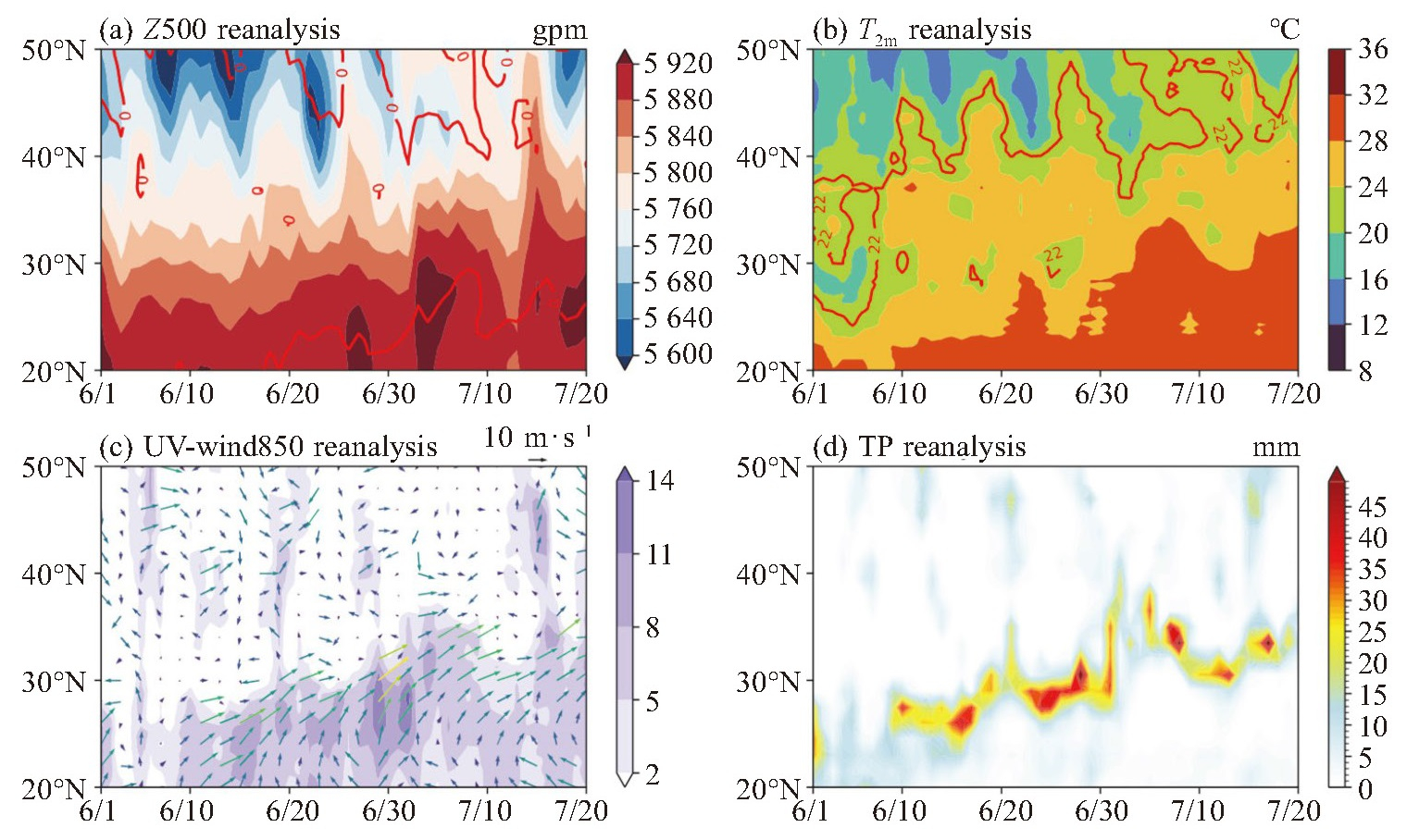| [1] |
梁萍, 孙国武, 马悦, 等. 梅雨变率和预测[M]. 北京: 中国环境出版集团, 2023.
|
| [2] |
梁萍, 杨子凡, 谢潇, 等. 上海梅汛期候降水异常的低频信号及延伸期预报[J]. 气象科技, 2020, 48(5): 685-694.
|
| [3] |
王遵娅, 丁一汇. 夏季长江中下游旱涝年季节内振荡气候特征[J]. 应用气象学报, 2008, 19(6): 710-715.
|
| [4] |
曹鑫, 任雪娟, 杨修群, 等. 中国东南部5—8月持续性强降水和环流异常的准双周振荡[J]. 气象学报, 2012, 70(4): 766-778.
|
| [5] |
陈蔚, 刘梅, 杨华栋, 等. 长江中下游典型涝年准双周振荡特征及其影响分析[J]. 气象学报, 2023, 81(3): 393-415.
|
| [6] |
DING Y H, LIU Y Y, HU Z Z. The record-breaking Meiyu in 2020 and associated atmospheric circulation and tropical SST anomalies[J]. Advances in Atmospheric Sciences, 2021, 38(12): 1 980-1 993.
|
| [7] |
HUANG W R, LIU P Y, CHEN J H, et al. Impact of boreal summer intra-seasonal oscillations on the heavy rainfall events in Taiwan during the 2017 Meiyu season[J]. Atmosphere, 2019, 10(4): 205.
|
| [8] |
DING Y H, LIANG P, LIU Y J, et al. Multiscale variability of Meiyu and its prediction: A new review[J]. Journal of Geophysical Research: Atmospheres, 2020, 125(7): e2019JD031496.
|
| [9] |
刘芸芸, 丁一汇. 2020年超强梅雨特征及其成因分析[J]. 气象, 2020, 46(11): 1 393-1 404.
|
| [10] |
丁一汇, 梁萍. 基于MJO的延伸预报[J]. 气象, 2010, 36(7): 111-122.
|
| [11] |
金荣花, 马杰, 任宏昌, 等. 我国10~30天延伸期预报技术进展与发展对策[J]. 地球科学进展, 2019, 34(8): 814-825.
|
| [12] |
WCRP JOINT SCIENTIFIC COMMITTEE (JSC). World Climate Research Programme Strategic Plan 2019-2028[R]. Geneva: WCRP Publication, 2019.
|
| [13] |
ZHANG J P, SUN L Y, JIN C, et al. Recent advances in artificial intelligence generated content[J]. Frontiers of Information Technology & Electronic Engineering, 2024, 25(1): 1-6.
|
| [14] |
LYU Y, ZHU S P, ZHI X F, et al. Significant advancement in subseasonal-to-seasonal summer precipitation ensemble forecast skills in China mainland through an innovative hybrid CSG-UNET method[J]. Environmental Research Letters, 2024, 19(7): 074055.
|
| [15] |
LYU Y, ZHU S P, ZHI X F, et al. Improving subseasonal-to-seasonal prediction of summer extreme precipitation over southern China based on a deep learning method[J]. Geophysical Research Letters, 2023, 50(24): e2023GL106245.
|
| [16] |
杨淑贤, 零丰华, 应武杉, 等. 人工智能技术气候预测应用简介[J]. 大气科学学报, 2022, 45(5): 641-659.
|
| [17] |
DUEBEN P D, BAUER P. Challenges and design choices for global weather and climate models based on machine learning[J]. Geoscientific Model Development, 2018, 11(10): 3 999-4 009.
|
| [18] |
WEYN J A, DURRAN D R, CARUANA R. Can machines learn to predict weather? Using deep learning to predict gridded 500-hPa geopotential height from historical weather data[J]. Journal of Advances in Modeling Earth Systems, 2019, 11(8): 2 680-2 693.
|
| [19] |
ZHANG Y C, LONG M S, CHEN K Y, et al. Skillful nowcasting of extreme precipitation with NowcastNet[J]. Nature, 2023, 619(7970): 526-532.
|
| [20] |
SCHULTZ M G, BETANCOURT C, GONG B, et al. Can deep learning beat numerical weather prediction?[J]. Philosophical Transactions of the Royal Society A, 2021, 379(2194): 20200097.
|
| [21] |
KURTH T, SUBRAMANIAN S, HARRINGTON P, et al. Fourcastnet: Accelerating global high-resolution weather forecasting using adaptive Fourier neural operators[C]//Proceedings of the platform for advanced scientific computing conference. 2023: 1-11.
|
| [22] |
CHEN L, ZHONG X, ZHANG F, et al. FuXi: A cascade machine learning forecasting system for 15-day global weather forecast[J]. npj Climate and Atmospheric Science, 2023, 6(1): 190.
|
| [23] |
LAM R, SANCHEZ-GONZALEZ A, WILLSON M, et al. Learning skillful medium-range global weather forecasting[J]. Science, 2023, 382 (6677): 1 416-1 421.
|
| [24] |
BI K F, XIE L X, ZHANG H H, et al. Accurate medium-range global weather forecasting with 3D neural networks[J]. Nature, 2023, 619 (7970): 533-538.
|
| [25] |
CHEN K, HAN T, GONG J, et al. Fengwu: Pushing the skillful global medium-range weather forecast beyond 10 days lead[J]. arXiv, 2023.
|
| [26] |
黄小猛, 林岩銮, 熊巍, 等. 数值预报AI气象大模型国际发展动态研究[J]. 大气科学学报, 2024, 47(1): 46-54.
|
| [27] |
OLIVETTI L, MESSORI G. Do data-driven models beat numerical models in forecasting weather extremes? A comparison of IFS HRES, Pangu-Weather and GraphCast[J]. EGUsphere, 2024, 2024: 1-35.
|
| [28] |
XU H X, ZHAO Y, ZHAO D J, et al. Improvement of disastrous extreme precipitation forecasting in North China by Pangu-weather AI-driven regional WRF model[J]. Environmental Research Letters, 2024, 19(5): 054051.
|
| [29] |
CHARLTON-PEREZ A J, DACRE H F, DRISCOLL S, et al. Do AI models produce better weather forecasts than physics-based models? A quantitative evaluation case study of Storm Ciarán[J]. npj Climate and Atmospheric Science, 2024, 7(1): 93.
|
| [30] |
王会军, 戴永久, 杨崧, 等. 气候系统预测: 基础创新和集成应用[J]. 大气科学学报, 2024, 47(2): 161-172.
|
| [31] |
HERSBACH H, BELL B, BERRISFORD P, et al. The ERA5 global reanalysis[J]. Quarterly Journal of the Royal Meteorological Society, 2020, 146(730): 1 999-2 049.
|
| [32] |
HUANG G, WANG Y, HAM Y G, et al. Toward a learnable climate model in the artificial intelligence era[J]. Advances in Atmospheric Sciences, 2024, 41: 1 281-1 288.
|
| [33] |
GUIBAS J, MARDANI M, LI Z Y, et al. Efficient token mixing for transformers via adaptive Fourier neural operators[C]//International Conference on Learning Representations. 2022.
|
| [34] |
LI Y, SUN Y, WANG W W, et al. U-shaped transformer with frequency-band aware attention for speech enhancement[J]. IEEE / ACM Transactions on Audio, Speech, and Language Processing, 2023, 31: 1 511-1 521.
|
| [35] |
姚菊香, 王盘兴, 李丽平. 季节内振荡研究中两种数字滤波器的性能对比[J]. 南京气象学院学报, 2005, 28(2): 248-253.
|
| [36] |
王文, 孙畅, 蔡晓军, 等. 南亚高压低频振荡与长江中下游地区旱涝的关系[J]. 地球科学进展, 2016, 31(5): 529-541.
|
| [37] |
CHEN L, ZHONG X H, LI H, et al. A machine learning model that outperforms conventional global subseasonal forecast models[J]. Nature Communications, 2024, 15(1): 6 425.
|






 下载:
下载:
















 粤公网安备 4401069904700003号
粤公网安备 4401069904700003号